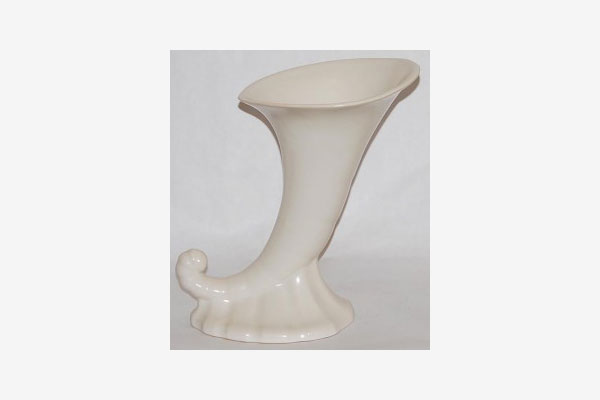It’s always a risk for any company – be it a clothing designer or an artist – to present a solid white line. When it’s good, it quickly becomes an elegant and simple testament to whatever it is being offered and when Roseville Pottery introduced its Ivory line in 1932, it was possibly one of the biggest gambles the company ever made from an artistic approach. The Roseville Lustre had been released ten years earlier and it was incredibly successful, partly because of the vibrancy in the colors and glaze as well as its white clay body. A few years later, in 1928, the Roseville Normandy was released. It too is known for its intricate designs and colors – mostly green as its foundation. To then present an entire collection of matte  white art pottery was a bold move. But it certainly paid off.
white art pottery was a bold move. But it certainly paid off.
In the catalog and in many of the ads, it was described as a collection with an “utter absence of color”. That absence of color, however, bode well with this particular collection since the shapes and other design elements were so fluid and thoughtfully designed. There were lovely window boxes that had easy vining efforts and gentle curving features and several dual-handle vases that boasted simplicity without looking plain. In a 1939 catalog – it was still a popular line then – the company reiterated its efforts of “lend(ing) dignity and beauty…and it will harmonize with all colors”. Indeed it did.
Another selling point the company used was its affordability, stating, “the pieces retail from 50 cents to $10, so that whether you are in the low or high price market, you can find your level”. Because it was such a huge success, each season new shapes were added. In fact, new shapes were designed that were used only in the Ivory line.
Ultimately, by the time the Ivory line was retired, it had been made available in 183 shapes. Several bowls in various sizes, vases, pillow vases, bud vases, sand jars and candlesticks were just a few of the shapes. The fact that it was a simple white matte frankly added a certain sophistication and one that people were drawn to. It was a nice change of pace and despite the risky choice of following such a line as Roseville Normandy, there’s no denying that whoever made that decision had hit a home run. The Roseville Ivory line remains as popular and collectible today as it was in the 1930s.


